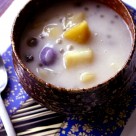No fiesta in our family passes by without this delicious filipino kakanin dessert. For the newbies of this Filipino dessert sapin- sapin are layered and colored confections of sticky rice, ube and squash cake topped with latik (caramelized coconut milk). Food historians claim that this delicacy originated in Abra, in the northern part of the Philippines. The original sapin-sapin are separate segments of blue, white and yellow color that are just put together. However most of the sapin-sapin we buy in the market is the shortened version were different colors were added but no flavor at all. This is my auntie’s famous sapin sapin recipe. And of course she used to sell them on the street when she was still young.
Ingredients:
2 Cups of glutinous rice flour (galapong)
1 ½ Cups of white sugar
1 ½ Cups of cooked and mashed squash
1 ½ cups of cooked and mashed ube (violet yam)
4 Cups of coconut cream
food coloring yellow and violet
pandan extract
½ tsp anise extract
some banana leaves
Procedure:
In a bowl mix your flour, with your sugar, pandan extract, anise extract and coconut milk. Mix them until it becomes homogenous. Line your round pan (preferably about 9 inches in size) with your banana leaves. Divide your flour mixture into three portions. Add the squash and yellow coloring on the first, the ube and purple coloring for the second and nothing for the last one. Preheat your steamer for about five minutes. Pour the yellow color first on your round pan and let it steam for fifteen minutes. Then followed by the violet one, let it steam for fifteen minutes. And lastly the third one also for another fifteen minutes. Sapin sapin is done when it becomes firm. Let it stand. Served it with roasted coconut and sugar on the top before serving. You can make variations of this dessert by replacing the squash with langka and adding some macapuno on the white segment instead of just plain galapong. Enjoy!
Related Posts
Tagged: coconut, coconut milk, Filipino Dessert Recipe, langka, macapuno, sapin sapin




 Mabuhay! This is a place for all Pinoy food lovers! It's about time the world discovers the wonders of Filipino cuisine. Hop on and enjoy our daily culinary journey.
Mabuhay! This is a place for all Pinoy food lovers! It's about time the world discovers the wonders of Filipino cuisine. Hop on and enjoy our daily culinary journey. 





it’s not wobbly…it’s so solid….hmmmm…not a good one
I was really excited to make it; but when I made it it wasnt the sapin sapin that I expected to turn out. Its so hard. Its no Good. Maybe to change the half rice flour to half gloutinous rice flour I suggest.
Hi.
the reason why it turned out solid is because it should be glutinous rice flour. The author should have mentioned that clearly…. Check other online recipes
Hi,
I made mine with just glutinous flour, mine turned out perfect
and when warmed up… OMG! it was the best tasting sapin sapin i’ve made.
sapin sapin talaga … wo0ww filipino taste is from the filipino pridee.. wo0weee…
sapin sapin is the best medicine ..
Yummm yummy yummm tastes soo yummy.
wow looks yummy
The directions fail to explain when to use the pandan and anise extracts. Any ideas?
I just updated the recipe , thanks kip